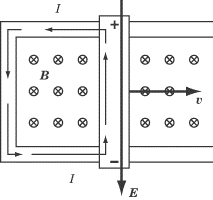Lesson: Chapter - 16
Motional Emf
Consider the bar in the figure below. It has length l and moves at speed v to the right in magnetic field
B, which is directed into the page.

The field exerts a magnetic force on the free electrons in the bar. That force
is
FB = q(v × B)
:
using the right-hand rule, you will find that the
v × B
vector is directed upward along the bar, but since electrons are negatively
charged, the magnetic force acting upon them is directed downward. As a result,
electrons flow to the bottom of the bar, and the bottom becomes negatively
charged while the top becomes positively charged.
Video Lesson
div>
The separation of charge in the rod creates an electric field within the bar in
the downward direction, since the top of the bar is positively charged and the
bottom of the bar is negatively charged. The force from the electric field,
FE = qE
,
pulls negative charges upward while the force from the magnetic field pulls
negative charges downward. Initially, the magnetic field is much stronger than
the electric field, but as more electrons are drawn to the bottom of the bar,
the electric field becomes increasingly stronger. When the two fields are of
equal strength, the forces balance one another out, halting the flow of
electrons in the bar. This takes place when:
FE = -FB
qE = -q(v × B)
E = -(v × B)
Induced Current and Motional Emf
The electric field in the metal bar causes a potential difference of
V = El =
vBl. If the bar slides along
metal rails, as in the figure below, a closed circuit is set up with current
flowing in the counterclockwise direction, up the bar and then around the metal
rail back to the bottom of the bar. This is called an induced current.

The moving bar is a source of an electromotive force, called motional emf,
since the emf is generated by the motion of the bar.
The force is defined as:

The magnitude of the induced emf can be increased by increasing the strength of
the magnetic field, moving the bar faster, or using a longer bar.
Example
A bar of length 10 cm slides along metal rails at a speed of 5 m/s in a magnetic
field of 0.1 T. What is the motional emf induced in the bar and rails?
Now that we’ve defined motional emf, solving this problem is simply a matter of
plugging numbers into the appropriate equation:

Next to display next topic in the chapter.
Practice Questions
Video Lessons and 10 Fully Explained Grand Tests
Large number of solved practice MCQ with explanations. Video Lessons and 10 Fully explained Grand/Full Tests.